The Bizarre History of ‘Mommie Dearest’: If Only All Movies ‘Failed as Successfully’ as Faye Dunaway’s Cold-Cream-Fueled Nightmare
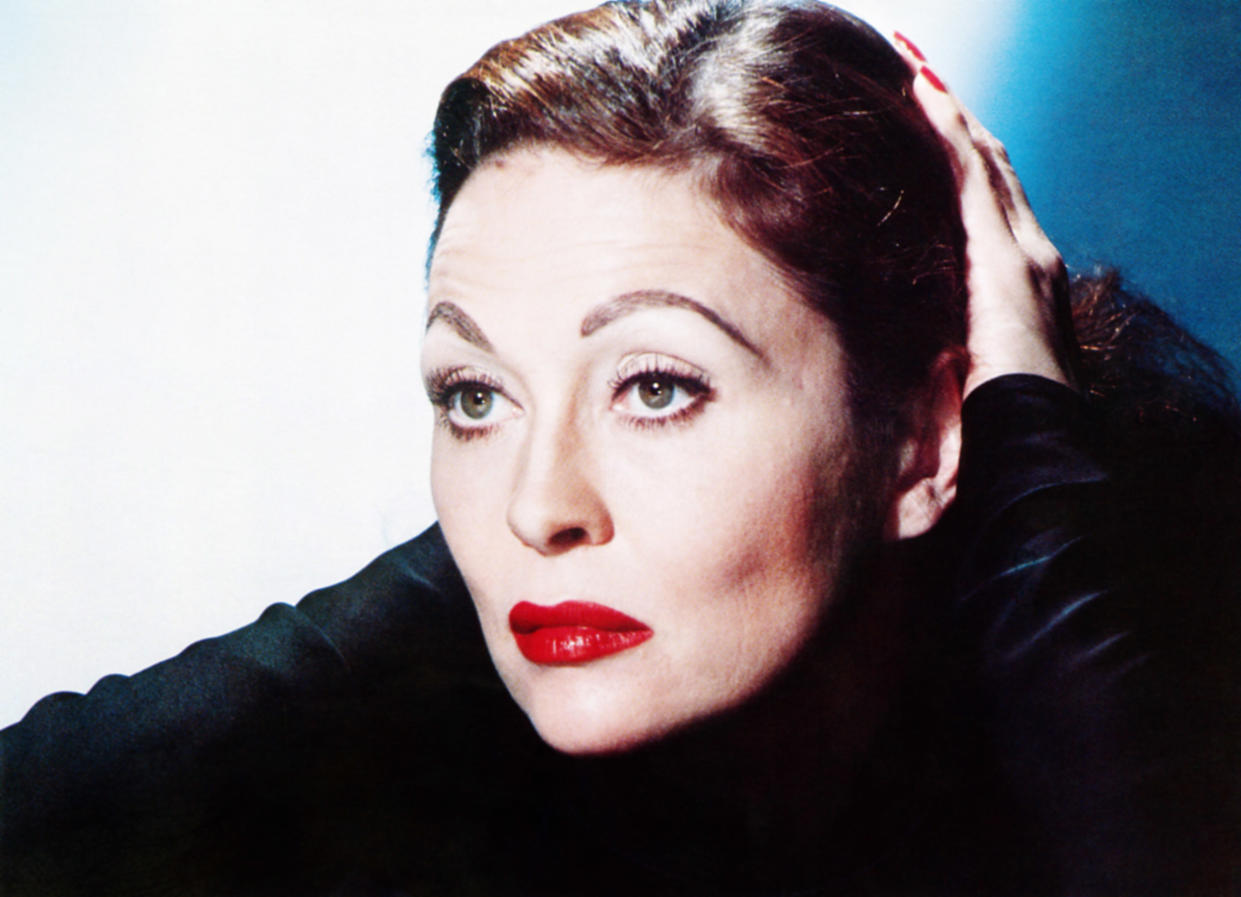
A camp classic, an unsung masterpiece, “Mommie Dearest” has been accused of many things, but never of being forgettable.
Frank Perry’s 1981 Paramount film, initially laughed at by audiences and critics, remains one of Faye Dunaway’s most iconic films and — thanks to the star slathered in cold cream, screaming, “No wire hangers, ever!” — one of the most quoted movies ever.
More from IndieWire
“‘Mommie Dearest’ was released the same year as ‘Chariots of Fire’ and a lot of other high-profile movies. And yet, here we are, 43 years later, talking about ‘Mommie Dearest,’ a movie that has long been derided as a critical failure and a cinematic bomb and … pick an adjective,” A. Ashley Hoff, a film historian and the author of the new book “With Love, Mommie Dearest: The Making of an Unintentional Camp Classic,” told IndieWire.
“A lot of people have watched this film many, many times — sometimes for cathartic reasons, sometimes because they appreciate old Hollywood, and of course for the unintentional comedy,” he said.
“With Love, Mommie Dearest” details the bumpy road to adapting Christina Crawford’s 1978 memoir about her adoptive mother Joan Crawford’s abuse. With exhaustive sourcing and new interviews, Hoff accounts for each small and large production mishap, from Dunaway tossing away a $50,000 brooch on the first day of filming to the many injuries sustained by Mara Hobel, who played little Christina. And with each bizarre revelation, Hoff explains how a film with Oscar hopes instead became camp fodder, both beloved and ridiculed.
Failure to launch
The film’s problems began from the word go, with a yearslong hunt for a script, director, and star.
According to the book, producer and former Paramount executive Frank Yablans was basically forced upon Christina Crawford when her memoir’s movie rights were being shopped. Yablans, who claimed he chased the project because she was a fellow abuse survivor, initially offered to let Crawford write the screenplay, knowing he would ultimately go with someone else. And after a few years and an estimated 18 drafts from various writers — including William Goldman (“Butch Cassidy and the Sundance Kid”) and, rumor had it, Joan Didion — he landed on the relatively unknown Tracy Hotchner, with whom he was also having an affair.
After shooting down script after script, the studio green-lit Hotchner’s version just months before filming. However, Hotchner discovered once production began that she was not credited as the writer. And when she did manage to negotiate a credit, she was given third billing — a surprise awaiting her at the film’s New York premiere.
“I saw that Frank Yablans and Perry had put their names on the film as having written it. I knew this was a terrible distortion of the truth — but was led to believe it was just ‘how things were,’ the men in charge took charge,” Hotchner reveals in the book.
“As a somewhat jarring postscript, I should add that I remained with Frank Yablans as his partner for nearly nineteen years, marrying him after thirteen years spent together,” she adds. “So the credit issue was an unspoken strange thorn in my side for a very long time.”
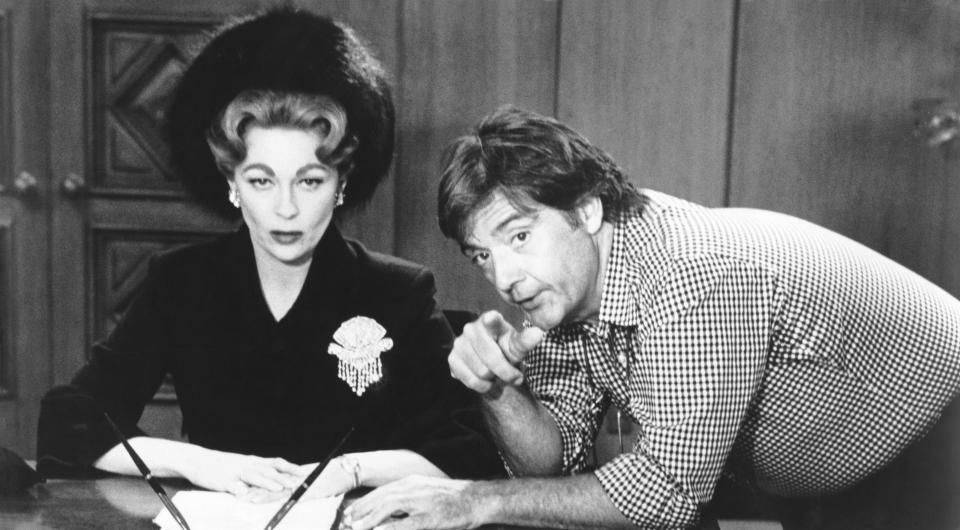
With a script in hand, next up was to secure a director and star who could work together. Anne Bancroft, who had a personal connection to Joan Crawford, had signed on to play the lead with Franco Zeffirelli (“Taming of the Shrew”) directing a script by James Kirkwood. But not long after Zeffirelli and Kirkwood were scrapped, Bancroft also exited — allegedly because she couldn’t stand Yablans’ new director, Frank Perry (“The Swimmer”) — leaving the long-delayed project without a Joan.
That’s when Dunaway, who’d starred in Perry’s 1971 film “Doc,” got wind the project still needed a lead. And hoping the film would deliver a much-needed hit, she allegedly did what any Method-trained actor worth her salt would do: show up for cocktails at the producer’s house in full character.
“When the time came for Faye to arrive, the doorbell rang, and Frank answered the door. There before him stood Joan Crawford. Or rather, Faye Dunaway dressed uncannily like Joan Crawford,” Hoff writes in the book, adding that the Franks, as Yablans and Perry were nicknamed, hired the actor right on the spot.
“It seemed like the perfect solution to all their problems,” he writes. “Of course, their problems had only just begun.”
The “clear-out club”
Dunaway was fresh off a string of low-profile projects and a newly formed reputation for being difficult on set, according to Hoff. To the “Mommie Dearest” production, she also brought even more baggage: her boyfriend, the photographer Terry O’Neill.
As “With Love, Mommie Dearest” lays out, Dunaway insisted in the final hour that O’Neill get a producer credit, so he had free rein to wander the set and, apparently, often did so drunk. That led to what’s described in the book as “historic” onset fights between him and Dunaway — who may have also occasionally been under the influence, according to several sources — and the rare entertaining moment.
“He had an idea for the famous fight scene, and he wanted to show the two Franks,” Jonathan Zimbert, Yablans’ assistant at the time, says of one day when O’Neill showed up to filming at a Los Angeles restaurant Perino’s “bombed.”
“Everything was blocked off but it was hundreds of people gathering around, and he proceeds to act out the fight all by himself, the wire hanger two-person fight,” he says, referring to when Joan goes berserk and beats young Christina with a wire hanger. “So he’s doing it all by himself, playing both parts and tumbling around in the gutter, and — I mean, it was something to see.”
But it wasn’t just O’Neill’s drunken presence that set Dunaway off, according to Hoff’s book. The crew allegedly lived in fear of accidentally being in the star’s eyeline while cameras rolled. Some crew started calling themselves the “clear-out club” after Dunaway demanded they clear off the beach during a shoot, forcing them to hide behind a single boom-mic operator. Some apparently even went as far as draping themselves in grip cloth to hide their faces.
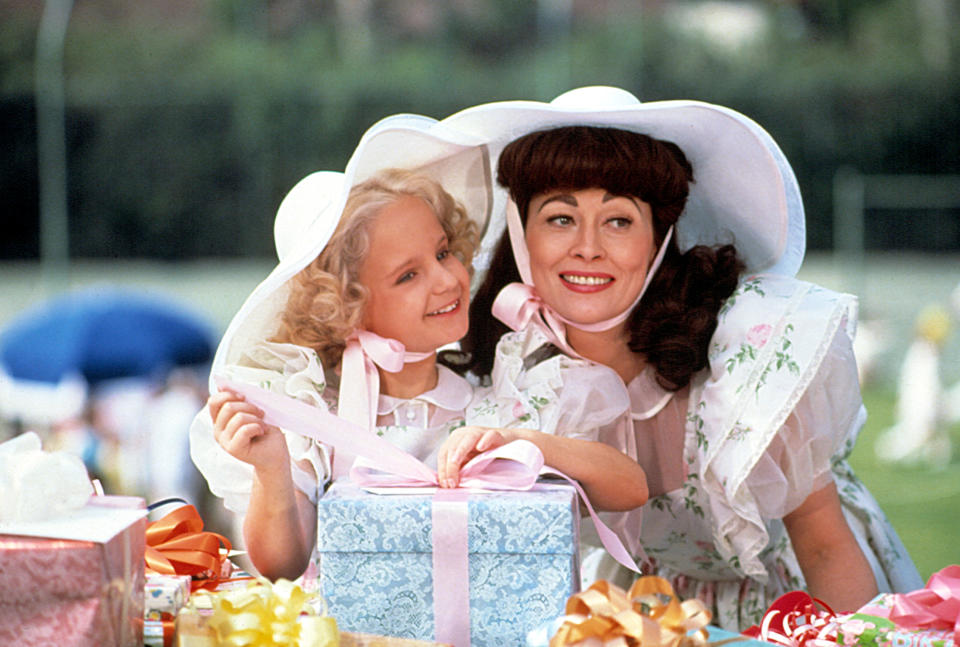
While the Franks ran interference between Dunaway and everyone else on set, they largely went along with her demands — excusing her as a perfectionist “possessed” by the spirit of Joan Crawford — according to the book.
“Frank Yablans and Frank Perry both admitted that, while filming was incredibly difficult and Faye was not the easiest star with which they had worked, they would have worked with her again in a heartbeat,” Hoff said, echoing the Franks’ words in several interviews. “So, at least in their view, the end result justified the means.”
It seems that some of Dunaway’s co-stars took a similar position, dismissing her behavior — which allegedly included holding up production for hours while she hid out in her dressing room or obsessed over hair and makeup — as the idiosyncrasies of a Method actor. But Rutanya Alda, a fellow Method actor who played Joan’s right-hand woman, Carol Ann, was not one of them.
“Joan got her way in a ladylike way. Faye was despised because she was so rude to people. Everyone was on pins and needles when she worked, and everyone relaxed when she didn’t,” Alda, who wrote a 2015 memoir titled “The Mommie Dearest Diary: Carol Ann Tells All,” says in the book.
The two faces of Christina
Alda, who also claims she was forced to play down her looks to keep the peace, may not have enjoyed sharing a screen with Dunaway, but nine-year-old Mara Hobel certainly did. Perhaps because she garnered favor by appealing to Dunaway’s maternal side, as Hoff suggests, the young star relished her time making “Mommie Dearest” despite more than one potentially traumatizing moment on set.
As Hobel says in the book, for her screen test, she was asked to do the scene after the wire-hanger beating — when Joan drags Christina to the bathroom and starts dousing everything in Bon Ami — using actual Comet. As her eyes reddened and she struggled to breathe after the cut, she recalls, it was decided they would use a cornstarch-flour mixture for filming, “so it would be safe for all of us to be breathing it.” And that was just her first injury.
While filming a scene where Joan finds Christina playing at her vanity and begins savagely shearing off her hair, Dunaway accidentally jabbed Hobel in the arm with scissors, apparently because of difficult-to-maneuver wigs. Filming the wire-hanger scene, she got grazed again after Perry convinced Dunaway to actually hit her (wrapped in “thick suede or a leather and cotton”) rather than a dummy during takes.
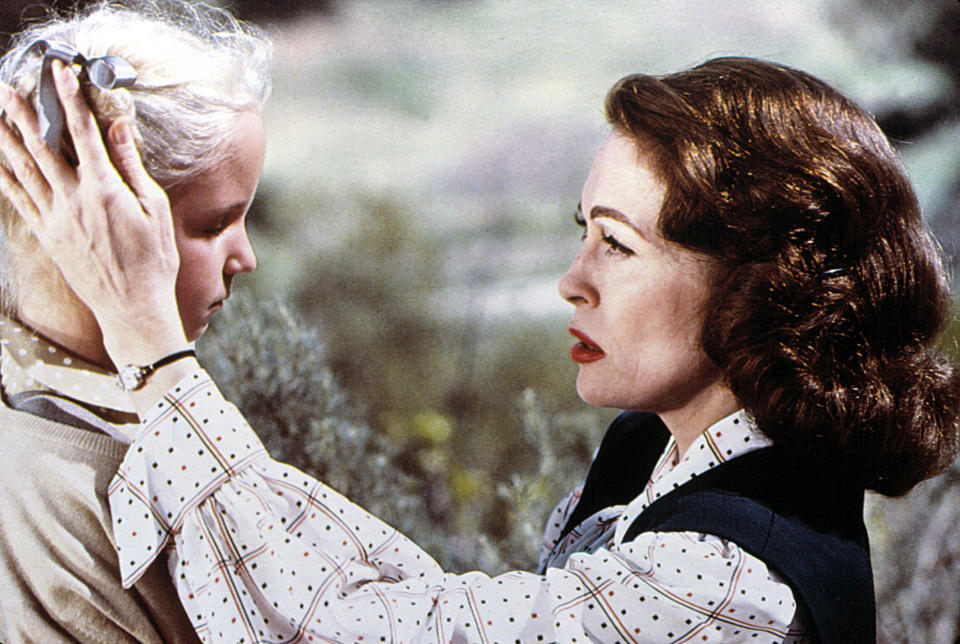
“Although I didn’t feel the sting on my back, I could feel the thumping of the hanger on my back, but no pain,” Hobel recalls in the book. “Unfortunately, my tush was not covered and she got me there once, but that’s OK, you know. It happens. The same thing happened with the scissors too.”
As Hobel and several other sources make clear, Dunaway — ultimately blamed by the Franks for the film’s brutality — was anything but careless while shooting the abuse sequences and, in fact, seems to have initially been opposed to involving the young actor. Though there may have been other times when she was so caught up in the performance that she forgot there were real people involved.
While filming the scene in which Joan wrestles adult Christina, played by Diana Scarwid, to the living room floor — prompted by her daughter screaming, “I am not one of your fans!” in earshot of a Redbook reporter — Dunaway allegedly showed an alarming lack of restraint and “literally almost killed” the younger actor, according to Perry, because she had become Joan Crawford.
But drunken debauchery and prop-related accidents don’t exactly explain how “Mommie Dearest” ended up being a critical flop (or a camp masterpiece). To answer that, Hoff looks at the most glaring issues with the film itself, beginning with the fact that so little is said of Joan Crawford the movie star.
According to some of Hoff’s sources, a longstanding feud between Yablans and his former co-worker, Paramount executive Barry Diller was the reason why piles of scripts were initially turned down for the project. And it also allegedly resulted in $350,000 getting trimmed from the budget days before filming, forcing Yablans to scrap the expensive opening sequence meant to lay the groundwork for a more fleshed-out Joan.
As Hotchner says, in her original opening, the scrappy, hard-as-nails star arrives at MGM and gives it her all filming “The Ice Follies of 1939,” despite breaking an ankle and being over the hill. But the final opening skates through Joan dunking her face in an ice bath, arriving at the studio, and then returning home to the slavish Carol Ann.
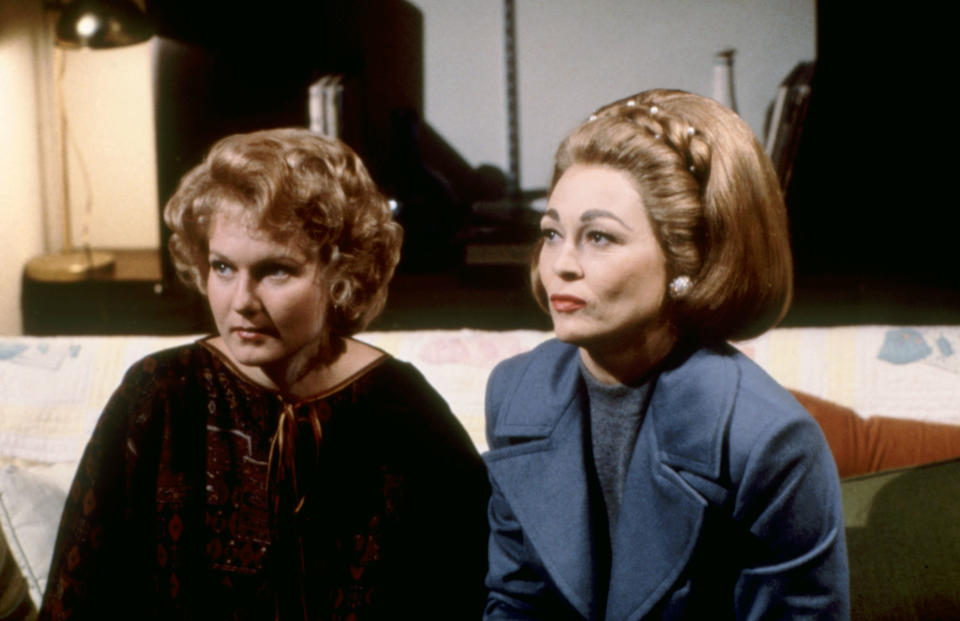
But up-front cost-cutting measures can’t be blamed for all the storyline issues, as some details — like young Christopher (Jeremy Scott Reinbolt) being strapped into his bed at night — purposefully went unexplained, while others were lost on the cutting room floor.
During the three-and-a-half-month shoot, which reportedly ended up $1 million over budget, several of the more expository scenes from Hotchner’s script did get filmed, as Hoff explains. But many — including a “tender” scene between Joan and young Christina on the beach and a moment of reconciliation toward the end — were cut by Perry in an effort to get the runtime down by about an hour.
“A lot of these scenes that might have softened the blow had to be removed. So, as a result, one minute we see Joan Crawford winning an Oscar, the next minute, she’s going off on her daughter in the middle of the night because, oops, a wire hanger was found in her closet,” Hoff said.
“The effect was that the audience members felt as abused as poor little Christina,” he added. “And, on the one hand, that’s a pretty terrifying thing. On the other hand, it made for a lot of nervous laughter, which then grew into a more rounded laughter.”
“The great American tragedy”
Despite their role in crafting the film, neither of the Franks — who “thought they had ‘the great American tragedy’ on their hands” after the rough cut, according to Zimbert — took responsibility for the film reading like a cold-cream-fueled nightmare. That job instead went to Dunaway, who was blamed for both the film’s budget issues and over-the-top portrayal of abuse upon the film’s September 1981 release. But it’s Dunaway’s performance that saved the film from obscurity, according to Hoff.
“Is she chewing the scenery? Absolutely. Is she over the top? Most definitely. But she was directed that way by Frank Perry, who saw the story in very operatic, theatrical terms,” Hoff said, referring to accusations that Dunaway’s overacting led to the film’s critical failure. “He kept directing her to be bigger and bolder. That was what he wanted and, obviously, that is what he got.”
He added, “The truth of the matter is, if she was anything less than the powerhouse that she was on screen, we would not be talking about this movie for decades on. She really had to be larger than life, and she was.”
In the book, Hoff argues that, beyond Dunaway’s performance, there were plenty of elements that contributed to “Mommie Dearest” not being taken seriously as a drama — from Carol Ann’s queer-coded devotion to Joan to its many, many lingering close-ups and young Christina’s occasional swerve into “discontent housewife.” But even more important than who or what made it camp is the fact that, at the end of the day, audiences embraced the film. And after grossing a little over $10 million in its first few weeks, prompting the studio to rebrand it as a dark comedy, it remained a talked-about film for over 40 years.
“People have asked me, ‘What did you learn during the researching and writing of this book?’ And I can honestly say that this made me reassess my ideas of what determines success and failure,” Hoff said. “I realized we should all fail as successfully as ‘Mommie Dearest.’”
“With Love, Mommie Dearest: The Making of an Unintentional Camp Classic” is now available from Chicago Review Press.
Best of IndieWire
Sign up for Indiewire's Newsletter. For the latest news, follow us on Facebook, Twitter, and Instagram.


